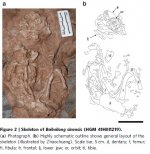Fred Ruhe
Well-known member

Hanyong Pu, Darla K. Zelenitsky, Junchang Lü, Philip J. Currie, Kenneth Carpenter, Li Xu, Eva B. Koppelhus, Songhai Jia, Le Xiao, Huali Chuang, Tianran Li, Martin Kundrát & Caizhi Shen (2017)
Perinate and eggs of a giant caenagnathid dinosaur from the Late Cretaceous of central China.
Nature Communications 8, Article number: 14952 (2017)
doi:10.1038/ncomms14952
Free pdf: https://www.nature.com/articles/ncomms14952
Abstract
The abundance of dinosaur eggs in Upper Cretaceous strata of Henan Province, China led to the collection and export of countless such fossils. One of these specimens, recently repatriated to China, is a partial clutch of large dinosaur eggs (Macroelongatoolithus) with a closely associated small theropod skeleton. Here we identify the specimen as an embryo and eggs of a new, large caenagnathid oviraptorosaur, Beibeilong sinensis. This specimen is the first known association between skeletal remains and eggs of caenagnathids. Caenagnathids and oviraptorids share similarities in their eggs and clutches, although the eggs of Beibeilong are significantly larger than those of oviraptorids and indicate an adult body size comparable to a gigantic caenagnathid. An abundance of Macroelongatoolithus eggs reported from Asia and North America contrasts with the dearth of giant caenagnathid skeletal remains. Regardless, the large caenagnathid-Macroelongatoolithus association revealed here suggests these dinosaurs were relatively common during the early Late Cretaceous.
Beibeilong sinensis gen. et sp. nov.
Etymology. The generic name is derived from Chinese Pinyin ‘beibei’ for baby and ‘long’ for dragon. The specific name is derived from Latin referring to its discovery in China.
News:
http://www.sciencemag.org/news/2017/05/smuggled-dino-eggs-gave-birth-baby-dragons
http://news.nationalgeographic.com/2017/05/baby-louie-dinosaurs-giant-eggs-new-species/
http://www.the-scientist.com/?artic...rs-to-Scientists--New-Dino-Species-Described/
http://www.ucalgary.ca/utoday/issue/2017-05-09/big-baby-louie-now-has-dinosaur-family
https://phys.org/news/2017-05-baby-gigantic-oviraptor-like-dinosaur-species.html
Enjoy,
Fred
Some pictures of the new species:
Perinate and eggs of a giant caenagnathid dinosaur from the Late Cretaceous of central China.
Nature Communications 8, Article number: 14952 (2017)
doi:10.1038/ncomms14952
Free pdf: https://www.nature.com/articles/ncomms14952
Abstract
The abundance of dinosaur eggs in Upper Cretaceous strata of Henan Province, China led to the collection and export of countless such fossils. One of these specimens, recently repatriated to China, is a partial clutch of large dinosaur eggs (Macroelongatoolithus) with a closely associated small theropod skeleton. Here we identify the specimen as an embryo and eggs of a new, large caenagnathid oviraptorosaur, Beibeilong sinensis. This specimen is the first known association between skeletal remains and eggs of caenagnathids. Caenagnathids and oviraptorids share similarities in their eggs and clutches, although the eggs of Beibeilong are significantly larger than those of oviraptorids and indicate an adult body size comparable to a gigantic caenagnathid. An abundance of Macroelongatoolithus eggs reported from Asia and North America contrasts with the dearth of giant caenagnathid skeletal remains. Regardless, the large caenagnathid-Macroelongatoolithus association revealed here suggests these dinosaurs were relatively common during the early Late Cretaceous.
Beibeilong sinensis gen. et sp. nov.
Etymology. The generic name is derived from Chinese Pinyin ‘beibei’ for baby and ‘long’ for dragon. The specific name is derived from Latin referring to its discovery in China.
News:
http://www.sciencemag.org/news/2017/05/smuggled-dino-eggs-gave-birth-baby-dragons
http://news.nationalgeographic.com/2017/05/baby-louie-dinosaurs-giant-eggs-new-species/
http://www.the-scientist.com/?artic...rs-to-Scientists--New-Dino-Species-Described/
http://www.ucalgary.ca/utoday/issue/2017-05-09/big-baby-louie-now-has-dinosaur-family
https://phys.org/news/2017-05-baby-gigantic-oviraptor-like-dinosaur-species.html
Enjoy,
Fred
Some pictures of the new species:





